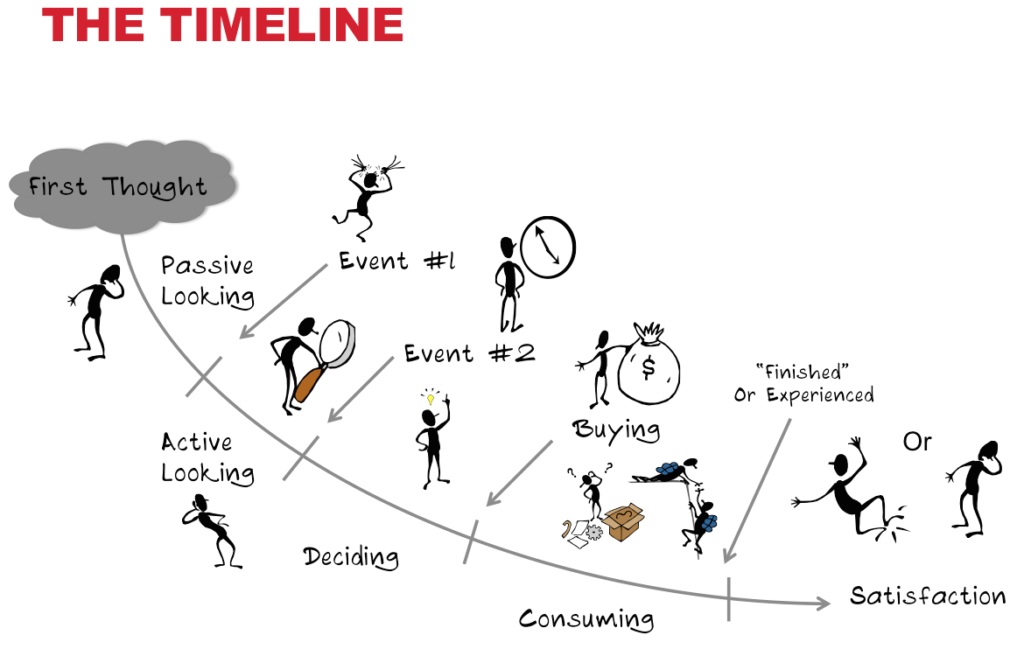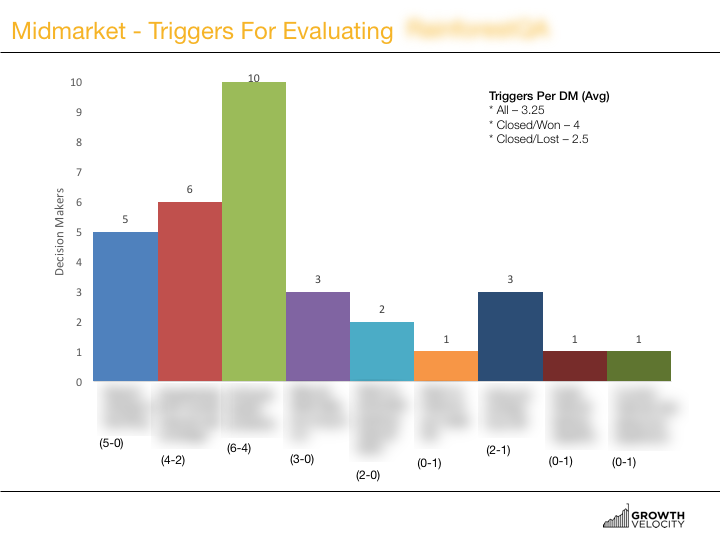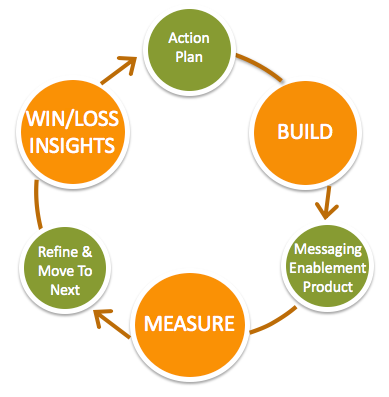Once you stop learning you start dying
—Albert Einstein
Last quarter’s deal outcomes are fresh data just begging to be put to good use, and Win/Loss Analysis is the best way to do it.
In this article, I offer 24 ways to ace your Win/Loss Analysis (here’s a good definition) — so you increase conversion from first touch to close by learning from last quarter’s deal outcomes.
Get in touch about our Win/Loss Analysis Service if you want the insights, but don’t have the time to do this work yourself.
Begin with a purpose
First things first, what is the program’s purpose? That is, prioritize one specific situation where deal outcomes are below target, and set a goal for improvement.
#1. Deal type (eg, land, expand, renewal), buyer vertical, and competitive presence are all good parameters for defining the situation.
#2. Set a goal for improvement, and choose a metric (eg MQL to SQL conversion rate, opportunity win rate, etc) to measure results. This goes a long way to justifying the time spent on your program — not just the interviews and analysis, but the changes you’ll need help implementing to improve outcomes.
#3. Collect a “before” reading as a benchmark, and agree on timing for an “after” reading which is likely a full sales cycle after you finish making improvements based on the Win/Loss Analysis.
#4. Socialize this initial plan. Input and vocal support from functional leaders (especially sales, marketing, and product) at the outset makes it more likely they’ll participate in operationalizing the insights generated. Your CEO’s vocal support will be helpful, especially when it’s time to act on the insights.
The graphic below shows how a Learn-Build-Measure process can be used to iteratively improve deal outcomes when two or more buying situations are below target. Stack rank the situations and work through them with a series of Win/Loss Analyses.
Select deals and contact champions
The sample size for a Win/Loss Analysis should generally be no less than twenty buyer interviews. That’s 10 Closed/Won opportunities and 10 Closed/Lost opportunities.
#5. Compare apples to apples. The selected deals must be identical in key respects to pick up strong, potent correlations between the issues covered in buyer interviews and deal outcomes.
#6. While it’s sometimes necessary to include deals that closed more than 90 days prior, those interviews may be less vibrant, since the buying experience isn’t fresh.
#7. Screen out Closed-Lost opportunities that didn’t make it to an advanced “stage” of discussion. This ensures the buyer was seriously interested and can provide detailed feedback.
#8. Review with Sales the report of deals meeting your criteria, and revise. Ask which accounts will be most receptive, and which to avoid, particularly customers where there’s follow-on sales activity. Reps can also advise on which contact at each account will be willing and able to share experience across the entire buying process.
#9. When you’re ready to begin scheduling champions to participate, start your outreach with the more time consuming Closed-Lost deals.
#10. Use a research recruiter. [Shortcut alert!] If your Win/Loss Analysis is being run in-house, consider contracting with a research recruiter to contact and schedule participants. This offloads the two most time consuming pieces of the recruiting process. A recruiter’s fee will be approximately $300 per person recruited, plus any incentive offered to participants.
Interview champions
With focus and practice, you will get golden insights from just a 30-minute interview.
#11. Write an interview script, or “discussion guide.” A discussion guide ensures interviews stay on track and on time, cover all essential topics, and questions are phrased in consistent language. Rehearse it, tracking the time it requires, to ensure you can cover everything in the allotted time.
#12. While the list of potential topics is long, cap the interview at 30 minutes. We typically cover: buying context; trigger for considering a change; solution discovery; stakeholders on the buying team; hurdles to moving forward with the vendor post engagement; competing vendors in the consideration set; the top decision criteria, and the buyer’s assessment of the vendor’s offering vs the leading alternative on those criteria.
#13. An open mind is essential to learning from the buyer’s experience and perspective. The best interviewers are open and curious; they’re able to go beyond the discussion guide to generate deeper insights into decisions and actions. To counter the “closing” of the mind that accompanies domain expertise, an in-house interviewer can use casual conversations with friends and family to practice openness and curiosity about known topics. Ultimately, however, interview depth is a crucial advantage that comes from utilizing an independent win/loss analysis consultant.
#14. Use the Jobs To Be Done timeline to visualize the events leading to a purchase decision. We use the stages in the JTBD timeline (eg, Passive Looking, Active Looking, Deciding) to frame our interviews and discussion guide.

#15. Record the interviews. On a Mac, use Apple’s free QuickTime Player to record VoIP (eg Skype, Google Voice) and landline calls. To get the audio into my Mac from a landline phone, I use an iMic and Sandman’s Recording Adapter. For transcripts, TranscribeMe’s First Draft service is $0.79 per audio minute, and I’ve found rates as low as $0.33 per audio minute using Upwork.
#16. Take notes! Use a piece of scratch paper to scribble quick notes during each call that you can reference later in the call.
Analyze and operationalize
Analyze the interview data to identify what’s working for buyers, and what’s holding you back. Do the themes in the champions’ responses align with the prevailing beliefs about buyers inside your company?
#17. Find the main themes in champions’ responses to each topic. Begin by reviewing a sample of the responses on a topic to identify the main themes and give each a name (eg, “Recent change in tech stack”).
#18. Review all the interview transcripts to assign (“code”) each response to a theme, and then build a win-loss record for each theme to correlate it with deal outcomes. For example, you may find a 7-1 record for deals that included the trigger “Recent change in tech stack.” Clearly a trigger that’s associated with winning 7 of 8 deals (88% win rate) is something you want to factor into your list building, and potentially add to sales qualification to flag these high likelihood buyers.

#19. Consider using specialized software like MAXQDA, which is faster and more flexible than a spreadsheet for this analysis.
#20. Improved deal outcomes almost always require participation from multiple functions, so it’s essential to engage a cross-functional team of stakeholders in absorbing and understanding the buyer feedback, and planning for action. For this purpose, consider using Affinity Diagramming during a “buyer workshop.”

#21. Plan for action. In our onsite at a project’s conclusion, we also use Affinity Diagramming to generate a prioritized list of fixes and improvements which we record in a draft action plan.
Measure results
Use the “after” reading scheduled in your initial plan to measure the program’s impact on outcomes.
#22. If you met or surpassed your goal, consider applying your experience with Win/Loss Analysis to tackle a new problem area.
#23. If the win/loss didn’t improve your target metric, investigate why. Were there faulty conclusions about the causes of won and lost outcomes? Were there flaws in the action plan, such as actions that weren’t implemented, or implementation could be improved?
#24. Use the Sprint Retrospective as a model to get input from stakeholders on specific ways to improve.
Check our guide “How To Conduct A Win/Loss Analysis” for our latest best practices advice.
Related Posts
Sales Win Loss Analysis: Why Data-Driven Leaders Are Leveling Up
Sales win loss analysis helps leaders make data-driven decisions. What’s working and where can we double-down? What isn’t working, and how do we fix it?
Win/Loss Analysis Reports: 3 Things You’ll Learn
Which aspects of your product offering and buying experience are helping drive sales? And which aspects are hindering sales? This is what enterprise and mid-market software companies often struggle to understand. A good win/loss analysis report will provide the answers to these questions.
Three Reasons Sales Leaders Want Even More Data About Their Buyers
While B2B sales teams are literally swimming in data, it’s not enough. Data-driven sales leaders are using input directly from buyers to find new ways to improve win rate and lead with conviction.





